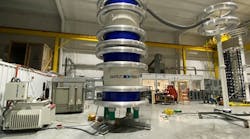Automatic circuit reclosers have long been applied for feeder protection in overhead distribution systems . . . generally to keep the lights on. Their mission is quite simple: detect a fault on the line, trip the interrupter to clear the fault, and then test the line to see if the fault is still there. If the fault is gone, the lights come back on.
Why test? The general consensus in the industry is that somewhere between 50% and 70% of faults on overhead power lines are temporary in nature. They can be caused, for example, by a wind-driven tree limb brushing against a line. Such faults clear themselves . . . sometimes after the initial trip, sometimes after the first reclose, sometimes after the second or third reclose. By testing the line, reclosers determine when the line has cleared and they remain closed—restoring power.
But the reclosing method of testing puts tremendous strain on the system. Every time the circuit is tested using an automatic circuit recloser—and the fault is still present—fault current flows from the source to the fault. Equipment located between the source and the fault is exposed to the high energy and suffers some level of damage as a result. While substation bus work is designed to be especially robust and likely won’t experience any long-term consequences from continued passage of through-faults, weak links at connections may eventually fail from the effects of repeated fast heating and cooling. Underground cable sections of lines have a particularly poor reputation because of their inability to withstand repeated fault currents.
Of greater concern, however, is the impact that through-faults have on substation transformers, which experience deflection of the windings every time a fault occurs—anywhere, on any circuit fed from the bus. The main culprit is the high peak currents associated with the first loop of an asymmetrical fault. Faults that are cleared slowly can cause fatigue to insulation and mechanical components too, due to the protracted heating.
Although the damage to a substation transformer from a given through-fault is small, the effects are cumulative. Transformer life will be shortened. How much? It’s hard to say because it depends on so many factors. There is little doubt that in today’s utility environment in which the goal is to extend the life of assets—while reducing inspection and maintenance costs to a minimum—any issue that reduces the life of such an expensive asset as a substation transformer must be addressed and remedied appropriately.
Unfortunately, damage due to through-faults is something that utility engineers and asset managers have had to live with . . . because the negative impact of long-term outages is much more severe than the slow shortening of life of assets. Likewise, utility customer-service personnel have had no choice but to live with “surge” complaints from customers on circuits fed from the same substation bus as the faulted circuit. Little could be done to reduce those voltage sags and improve customer service when you need to keep the lights on . . . until now.
S&C’s new IntelliRupter PulseCloser not only interrupts faults as fast or faster than a conventional recloser, but its method for testing the line—PulseClosing Technology— does not subject the line to repeated faults that cause the cumulative damage discussed above.
PulseClosing Technology uss a unique method of vacuum interrupter actuation to perform a very fast close-open operation, to test the line. At a very specific point on the voltage wave, PulseClosing puts a pulse of current on the line of sufficient voltage to break down the fault. This pulse is so short that the total energy is a negligible 2% of the let-through allowed by the fastest conventional recloser.
Since the peak current is slightly lower than the symmetric peak value—and only 5 ms long—even the most sensitive equipment won’t be affected by the small voltage sag associated with line testing using PulseClosing Technology. Such minute voltage sags are well within industry-accepted power quality standards. Your lines will experience less damage due to sags and you’ll receive fewer complaints from customers who aren’t even on the faulted circuit.

